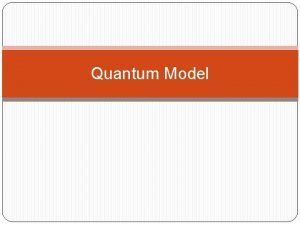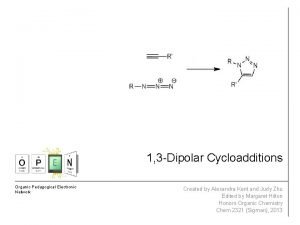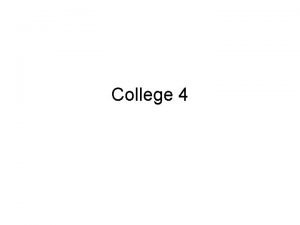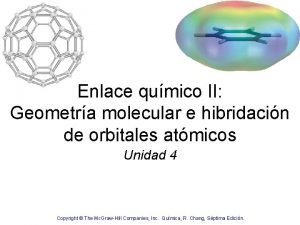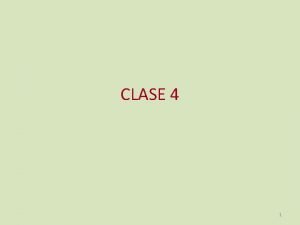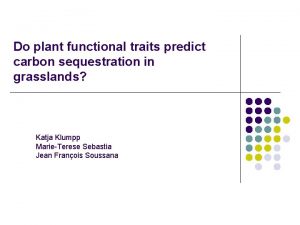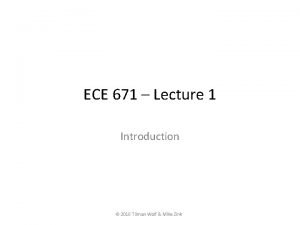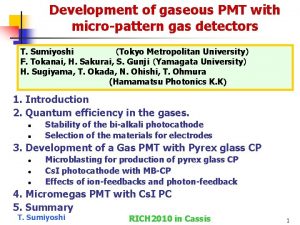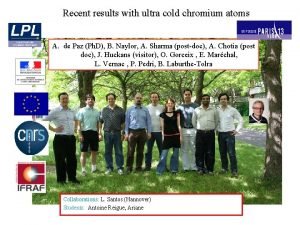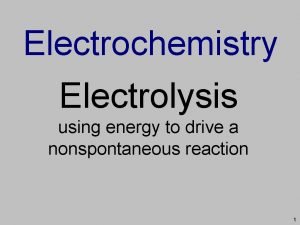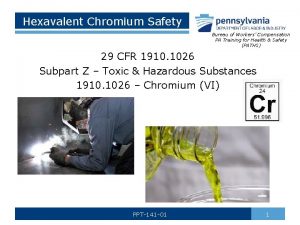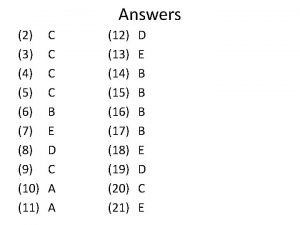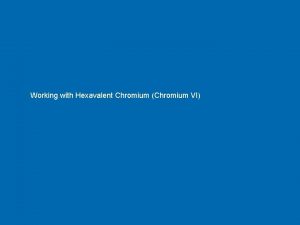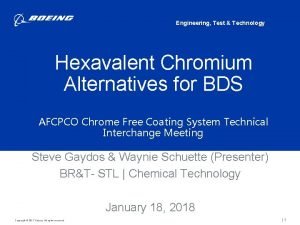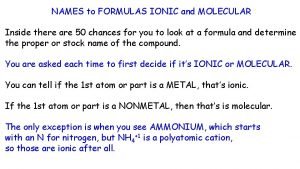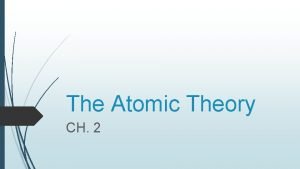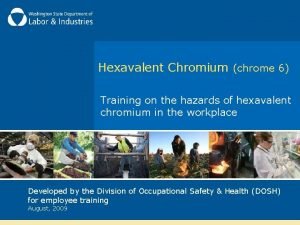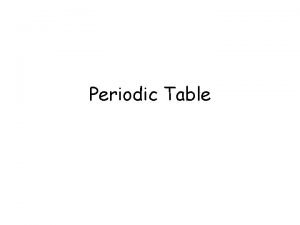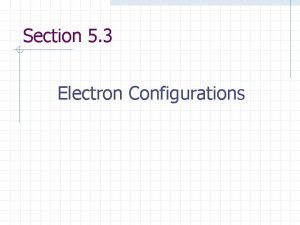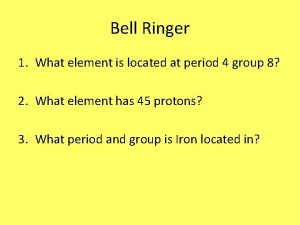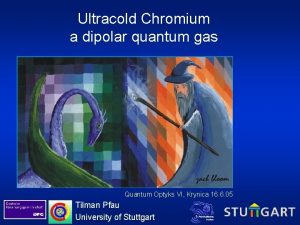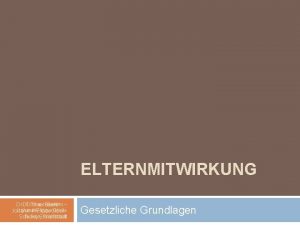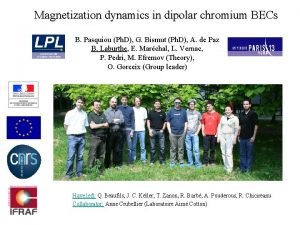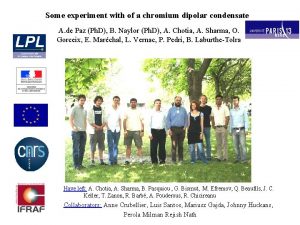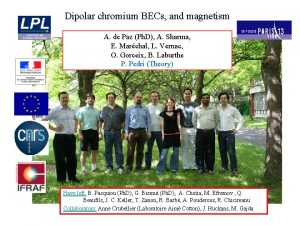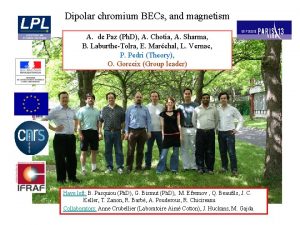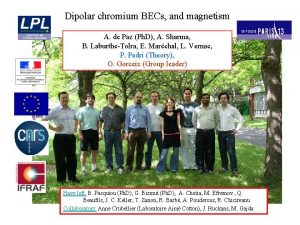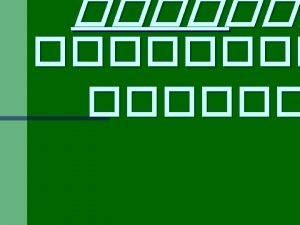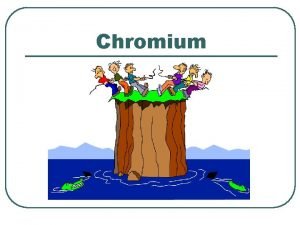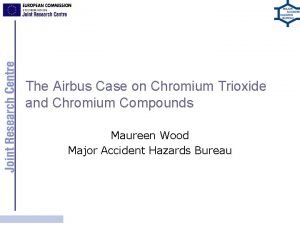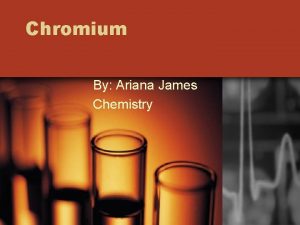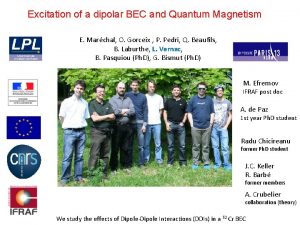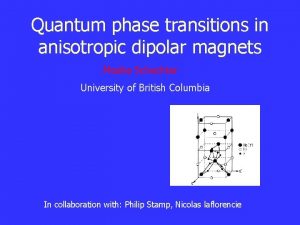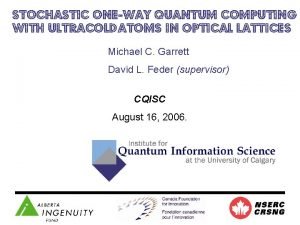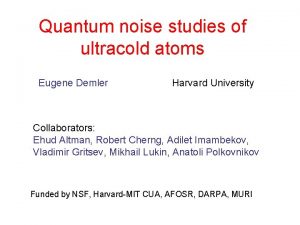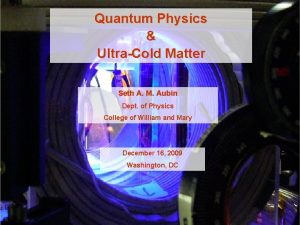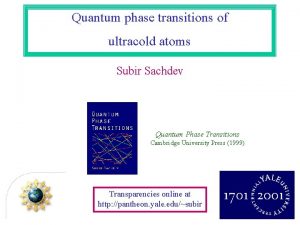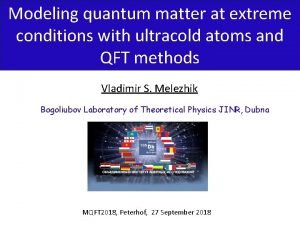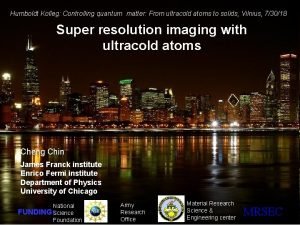towards Ultracold Chromium a dipolar quantum gas Tilman




















![Tuning the dipolar interaction spinning polarization z r [-1/2, 1] Tuning the dipolar interaction spinning polarization z r [-1/2, 1]](https://slidetodoc.com/presentation_image/7e3f3da4d2ad1598b77fadd4fd8cd313/image-21.jpg)














- Slides: 35

towards Ultracold Chromium a dipolar quantum gas Tilman Pfau University of Stuttgart

History of BEC Rb 1995 11 Na 1995 3 Li 1997 1 H 1998 1 10 1 3 5 2 1 1 1 2001 1 1 Cs 2002 1 Yb 2003 Cr 2004 1 1 He* 2001 K 3 1 1 1 Stuttgart, 25. Nov 12004 1

Chromium • No HFS • High magnetic moment 6 m. B Yb 70

Why bother?

Contact and Long Range Interaction in Quantum gases Contact interaction • isotropic • short range Dipolar interaction • anisotropic • long range z r nonlinear matter wave optics strong correlations: Bose-Hubbard. . . stability and ground state of BEC magnetism: Heisenberg, Ising, frustrated lattices. . .

Dipolar coupling in fluids Ferrofluids ~ 2 -20 nm Application: rotary seals in disk drives dampers for audio speakers

Dipolar coupling in gases? solid n ~1023/cm 3 Tc~ 1 K (Texc ~ 100 -1000 K) air n ~1019/cm 3 Tc~ 0. 1 m. K ultracold gas n ~1014/cm 3 Tc~ 1 n. K magnetic dipoles n <<1021/cm 3 Weak interaction: electric dipoles n <<109/cm 3

How strong is the dipolar interaction? dipole strength (tunable) compare to contact interaction: scattering length (tunable) atoms m Cr Rb Na edd=0. 15 edd=0. 007 edd=0. 003 magnetic dipoles heteronuclear molecules Rydberg atoms d e. g. : Ca. H, NH 3, Cr. Rb edd~100 e. g. : Rb (n=40) edd~108 electric dipoles

How to tame Chromium 4 stable isotopes: Bosons Fermion 52 Cr 50 Cr 54 Cr 53 Cr 83. 8% 4. 3% 2. 4% 9. 5%

Preparation of an ultracold Cr sample: • Continously loaded Ioffe Pritchard trap (CLIP-trap) J. Stuhler, et al. , Phys. Rev. A 64, 031405 (2001) P. O. Schmidt, et al. , J. Opt. B 5, S 170 (2003) • Compress IP-trap • Doppler cooling in the IP-trap at high offset field P. O. Schmidt, et al. , J. Opt. Soc. Am. B 20, 5 (2003) 2 x 108 atoms in the ground state phase space density r~10 -7 • Temperature is adjusted by evaporation

Evaporation in crossed trap BEC r~0. 5

Cr BEC T>Tc T<Tc tof 0… 13 msec T<Tc

T<Tc time of flight

Phase transition tof = 5 msec Decreasing T

Critical behaviour Condensate fraction ideal gas corr. for finite size and weak interaction exp. Tc~700 n. K nx=581 Hz ny=406 Hz nz=138 Hz

Lifetime and condensate formation t~ 6 sec n 0 i= 2 1014 cm-3 t~400 msec n 0 i= 2 1015 cm-3 Rb F=2, m. F=2 L 3 = 1. 8 10− 29 cm 6 s− 1 J. Söding et al. APB, 69, 257 (1999) Cr S=3, m. S=-3 L 3 < 1 10− 29 cm 6 s− 1

Dipolar interaction as perturbation • isotropic harmonic trap BEC without dipoles perturbation by dipole interaction: • Thomas –Fermi limit parabolic density profile n. TF(r) 2 RTF Fdd(r)

Dipolar interaction and the aspect ratio cf. anisotropic trap + contact interaction no dipoles Isotropic trap: + contact interaction + dipolar interaction in trap time of flight S. Giovanazzi, A. Görlitz, T. P. J. Opt. B 5, 208 (2003) no inversion !

Preliminary data on dipolar expansion 31 measurements aspect ratio ry/rz Theory with no free parameters S. Giovanazzi L. Santos P. Pedri y z nx=942 Hz ny=712 Hz nz=128 Hz time of flight [ms]

equations
![Tuning the dipolar interaction spinning polarization z r 12 1 Tuning the dipolar interaction spinning polarization z r [-1/2, 1]](https://slidetodoc.com/presentation_image/7e3f3da4d2ad1598b77fadd4fd8cd313/image-21.jpg)
Tuning the dipolar interaction spinning polarization z r [-1/2, 1]

Magic angle spinning in solid state NMR Random example: Solid sample Broadening by dipolar coupling

Stability diagram e. DD = 4 cigar trap shape pancake S. Giovanazzi, A. Görlitz, T. P. Phys. Rev. Lett. 89, 130401 (2002) magic angle 54. 7° K. Góral, K. Rzazewski, T. P. ; PRA, 61, 051601 (R) (2000) L. Santos, et al. ; PRL 85, 1791(2000)

How to tune a closed channel coupling open channel

Feshbach resonances I Quantum numbers - notation atomic electrons s, l molecular electrons S, L closed channel coupling molecular nuclei open channel

Feshbach resonances II Ab initio potentials S=2 S=4 model potentials S=6 Cr 2 from: Z. Pavlovic, B. O. Roos, R. Côté, and H. R. Sadeghpour Phys. Rev. A 69, 030701 (2004) Variational parameters: C 6, C 8, a Sensitive to last bound states

Feshbach resonances III model potentials Variational parameters: C 6, C 8, a Sensitive to last bound states plus centrifugal potentials (e. g. )

closed channel Selection rules Possible couplings: 2 nd order coupling open channel Spin - Orbit Spin - Spin Selection rules: first order not allowed! second order Momentum conservation:

S=6 MS -2 -3 -4 -5 -6 g - wave d - wave -4 -5 -6 X S=2 S=4 MS -2 -3 -4 MS 0 -1 -2 -2 -3 -4 X s - wave -4 -5 -6 initial state (open channel) first order second order 3 resonances 8 resonances

Our resonances (observed by losses) individual calibration by RF

Comparison exp vs. theory Theory: A. Simoni E. Tiesinga NIST Deviation exp-theo 0. 6 G

What do we now about Chromium know? S=2 S=4 S=6 a 6= 112(14) a 0 a 4= 58(6) a 0 a 2= -7(20) a 0 C 6=733(70)a. u. C 8=75(+90/-75)a. u.

Outlook for a dipolar BEC Play the dipolar game n expansion of a dipolar gas n Collective excitations n stability of a dipolar condensate L. Santos et al. , PRL 85(9): 1791, 2000 n dipolar order H. Pu et al. , PRL, 87: 140405, 2001 n macroscopic spin tunneling H. Pu et al. , PRL 89: 0904001, 2002 n roton in the dispersion relation L. Santos et al. , Phys. Rev. Lett. 90, 250403 (2003)

Further outlook Trap fermion Lithography: I. Averbukh controlled single atom deposition? cw atom laser ?

The dragon tamers S. Hensler A. Griesmaier T. Koch M. Fattori Former members: J. Werner P. O. Schmidt A. Görlitz J. Stuhler ph. D students and postdocs wanted! Theory: K. Rzazewski S. Giovanazzi A. Simoni E. Tiesinga P. Pedri L. Santos
 Orbital diagram chromium
Orbital diagram chromium Dipolar
Dipolar Dipolar bond
Dipolar bond Momento dipolar resultante
Momento dipolar resultante Como se calcula el momento dipolar
Como se calcula el momento dipolar Tilman
Tilman Tilman wolf
Tilman wolf Classical mechanics
Classical mechanics Quantum physics vs quantum mechanics
Quantum physics vs quantum mechanics Quantum gas
Quantum gas Ultra cold
Ultra cold What mass of chromium could be deposited by electrolysis
What mass of chromium could be deposited by electrolysis Copper orbital diagram
Copper orbital diagram Hexavalent chromium safety program
Hexavalent chromium safety program Triphosphorus pentasulfide
Triphosphorus pentasulfide Hexavalent chromium health effects
Hexavalent chromium health effects Bac 5709
Bac 5709 Chromium etchant 1020
Chromium etchant 1020 Rb3p ionic or covalent
Rb3p ionic or covalent Chromium bohr model
Chromium bohr model Hexavalent chromium training
Hexavalent chromium training Group 8 elements
Group 8 elements Chromium orbital configuration
Chromium orbital configuration Chromium 58 neutrons
Chromium 58 neutrons Gas leaked in bhopal gas tragedy
Gas leaked in bhopal gas tragedy Poisonous gas leaked in bhopal gas tragedy
Poisonous gas leaked in bhopal gas tragedy Gas law
Gas law Difference between ideal gas and real gas
Difference between ideal gas and real gas Gas reale e gas ideale
Gas reale e gas ideale Sutherland's law
Sutherland's law Reaksi pembentukan gas no2f dari gas no2 dan f2
Reaksi pembentukan gas no2f dari gas no2 dan f2 Derive ideal gas equation
Derive ideal gas equation Bhopal gas tragedy causes
Bhopal gas tragedy causes Flue gas desulfurisation gas filter
Flue gas desulfurisation gas filter Gas exchange key events in gas exchange
Gas exchange key events in gas exchange Imaginary gas
Imaginary gas
